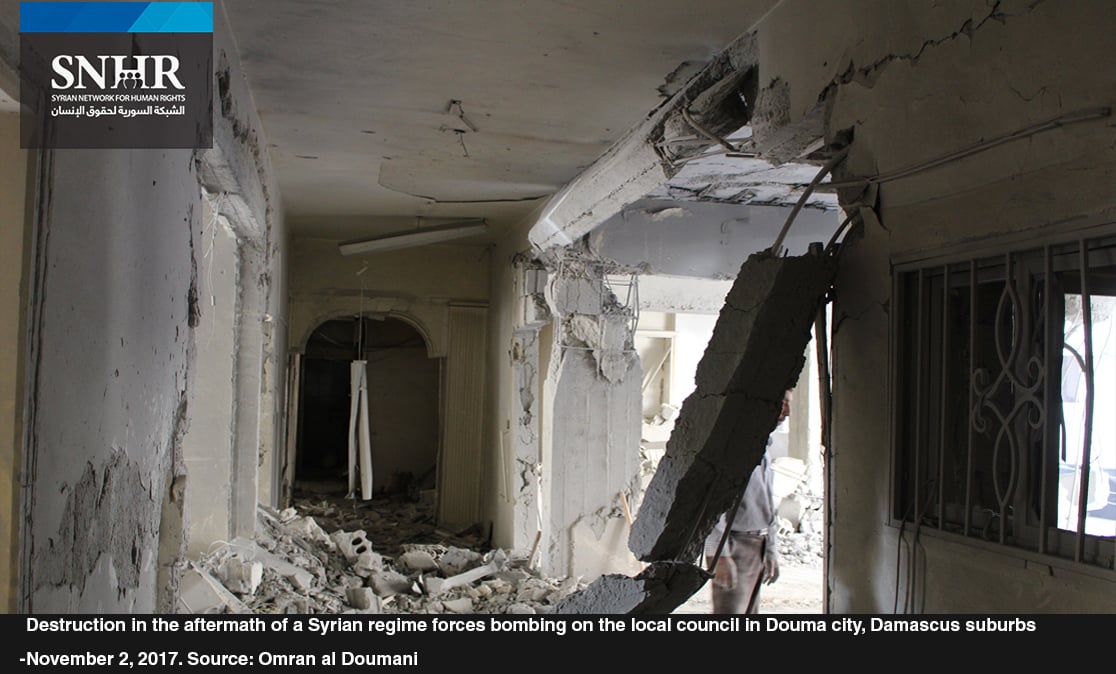Including 81 at the Hands of the Syrian-Russian Alliance

SNHR has published its special periodic report on attacks against vital civilian facilities by the parties to the conflict in Syria.
The report notes that a comprehensive ceasefire was announced from the Turkish capital Ankara under a Russian-Turkish sponsorship on December 30, 2016. The signing parties, the Syrian regime on one side and armed opposition factions on the other side, agreed to cease all armed attacks in the majority of the Syrian region. The military areas controlled by ISIS (self-proclaimed the Islamic State) were excluded from the agreement.
The report adds that Ankara Ceasefire Agreement was followed by seven rounds of talks that were held in Astana, Kazakhstan’s capital, between Russian, Turkish, and Iranian representatives as the states who sponsored Ankara Ceasefire Agreement. These rounds -the most recent of which was on October 30-31, 2017- discussed mostly, in parallel with a number of local agreements, ways to further establish de-escalation zones in Idlib governorate and the surrounding areas (parts of Aleppo, Hama, and Latakia governorates), northern Homs governorate, Eastern Ghouta, and parts of Daraa and Quneitra governorates in south Syria. Additionally, the talks addressed ways to deliver humanitarian aids and enable IDPs to return to those areas.
Since these agreements went into effect, the included areas saw a relatively good and noticeable drop in killing rates in relation to the past months since March 2011. Nonetheless, breaches didn’t stop, mainly by the Syrian regime, who is seemingly the party that would be most affected should the ceasefire go on, and in particular extrajudicial killing crimes and, more horrendously, deaths due to torture. This strongly asserts that there is a ceasefire of some sort on the table, but the crimes that the international community -especially the guarantors- won’t see are still going on as nothing had changed.
The report stresses that Syrian-Russian alliance have initiated a vicious offensive against Eastern Ghouta on the 14th of last November despite a de-escalation agreement that was reached in Eastern Ghouta between Jaish al Islam, an armed opposition faction, and Russian forces under an Egyptian sponsorship on Saturday, July 22, 2017, and was followed by a similar agreement with Failaq al Rahman faction that established the faction’s inclusion in the de-escalation zone in Eastern Ghouta on Wednesday, August 16, 2017.
The report says that a 38% rise was recorded in the number of vital civilian facilities that were attacked In November compared to October. Syrian regime forces continue to top all parties with approximately 63% of all attacks, followed by Russian forces with 21% of all attacks. We recorded 35 attacks in Eastern Ghouta by Syrian regime forces despite the ongoing de-escalation agreement.
The report documents 845 incidents of attack on vital civilian facilities between the start of 2017 and December of the same year. Moreover, the report records 98 incidents of attack in November, including 61 by Syrian regime forces and 20 by Russian forces while the remaining attacks were distributed as follows: two by Hay’at Tahrir al Sham, one by international coalition forces, one by factions from the armed opposition, and 13 by other parties.
The report breaks down the vital civilian facilities that were attacked in the month of November: 30 infrastructures, 26 places of worship, 15 vital medical facilities, 13 communal facilities, 11 vital educational facilities, and three refugee camps.
This report by SNHR only sheds light on the most notable incidents, as the report notes that the details of all incidents are kept in a database for the network, adding that the documented attacks were only the minimum of the actual magnitude of crimes in light of the many practical difficulties during the documentation process.
The report affirms that investigations conducted by SNHR show that there were no military centers before or during these attacks. Syrian regime forces and the other perpetrators of these crimes must justify their actions before the United Nations and the Security Council.
The type and number of evidences vary from one case to another. In light of the challenges we mentioned above, many of the incidents’ legal description change based on new evidences or clues that surface after we had released the report. We add these evidences and clues to our data archive. On the other hand, many incidents don’t constitute a violation to the international humanitarian law, but it involved collateral damages, so we record and archive these incidents to know what happened historically and to preserve it as a national record. However, they don’t necessarily qualify as crimes.
According to the report, the international humanitarian law considers indiscriminate, deliberate, or disproportionate attacks as unlawful attacks. Syrian regime forces’ attacks against schools, hospitals, churches, and bakeries is an utter disregard for the most basic standards of the international humanitarian law and the Security Council Resolution.
The report also notes that Russian forces, Hay’at Tahrir al Sham, factions from the armed opposition, international coalition forces, and other parties have attacked some of these facilities. The indiscriminate random bombardment is a violation of the international humanitarian law and amounts to a war crime.
The report calls on the Security Council to bind all parties, especially Syrian regime forces considering that it is the main perpetrator of most of these violations, to implement Resolution 2139 and, at least, condemn the targeting of vital civilian centers that are indispensable for the lives of civilians.
The report calls on the Russian guarantor to stop the Syrian regime from dooming all de-escalation agreements, and start making progress in the detainees issue by revealing the fates of 76,000 forcibly-disappeared persons.
Finally, the report calls on the states that support the armed opposition to cease their support for the factions that didn’t respect the international humanitarian law.


